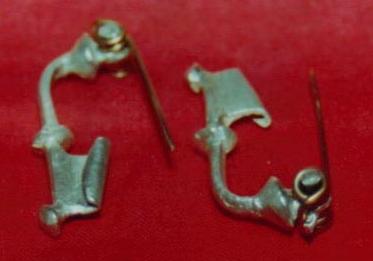Fibula
m |
(recat) |
||
| (9 intermediate revisions by 2 users not shown) | |||
| Line 1: | Line 1: | ||
{{LanguageBar | Fibula }} | {{LanguageBar | Fibula }} | ||
| + | [[Image:Fibulae.jpg|right|frame|Silver Fibulae made by Marcus Equitius Lentulus et Lucius Equitius Cincinnatus Augur, members of Legio XX (Maryland)]] | ||
| − | |||
| − | |||
A pin or clasp used to in relation to clothing. | A pin or clasp used to in relation to clothing. | ||
| + | |||
==Forms== | ==Forms== | ||
| Line 25: | Line 25: | ||
==Use== | ==Use== | ||
| − | [[Image:Dog fibula1.jpg|right|300px| | + | [[Image:Dog fibula1.jpg|right|300px|frame|A second zoomorphic fibula with dog. The pin was worn poining up. Illustration (C) used by permission.]] |
| − | + | ||
| − | + | ||
| + | Although fibulae are often illustrated in the "pin downwards" orientation, this might not have been the norm for fibulae. A zoomorphic plate brooch [http://www.findsdatabase.org.uk/hms/pas_obj.php?type=finds&id=00143ABFF1A01858] ("SWYOR-BFE1C5" in the UK "Portable Antiquities Scheme") shows a seated dog. The reverse clearly shows the pin attachment (with remains of pin) at the bottom, while the clasp portion is attached behind the dog's neck. | ||
==Vide== | ==Vide== | ||
| Line 35: | Line 34: | ||
*''Roman Era in Britain'' by John Ward (1911) Chapter XIV: "[http://penelope.uchicago.edu/Thayer/E/Gazetteer/Places/Europe/Great_Britain/_Periods/Roman/_Texts/WARREB/14*.html Dress and the Toilet]" | *''Roman Era in Britain'' by John Ward (1911) Chapter XIV: "[http://penelope.uchicago.edu/Thayer/E/Gazetteer/Places/Europe/Great_Britain/_Periods/Roman/_Texts/WARREB/14*.html Dress and the Toilet]" | ||
| − | |||
[[Category:Roman Clothing and Equipment]] | [[Category:Roman Clothing and Equipment]] | ||
Latest revision as of 15:50, 1 April 2009
Home | Latíné | Deutsch | Español | Français | Italiano | Magyar | Português | Română | Русский | English
⚜⚜⚜ Site Index - Key Pages ⚜⚜⚜
A pin or clasp used to in relation to clothing.
Contents |
Forms
The earliest fibulae date from the Iron Age. Fibula styles changed over time and show regional variations. Pins could be hinged or they might be either straight, curved, or wound springs. Fibulae could be plain, engraved, plated, enamelled, or jeweled. Designs might be simple, abstract or zoomorphic. Size varied greatly.
Broadly speaking there were three main types of fibulae: bow, plate and ring.
Bow
This is the "safety pin" shape and all of its variations.
Plate
This is the variety most like the modern "brooch".
Ring
The ring and pin configuration remained popular in the post-Roman period. The ring might be solid (annular) or it might have a gap (penannular).
Use
Although fibulae are often illustrated in the "pin downwards" orientation, this might not have been the norm for fibulae. A zoomorphic plate brooch [1] ("SWYOR-BFE1C5" in the UK "Portable Antiquities Scheme") shows a seated dog. The reverse clearly shows the pin attachment (with remains of pin) at the bottom, while the clasp portion is attached behind the dog's neck.
Vide
- Roman Era in Britain by John Ward (1911) Chapter XIV: "Dress and the Toilet"

